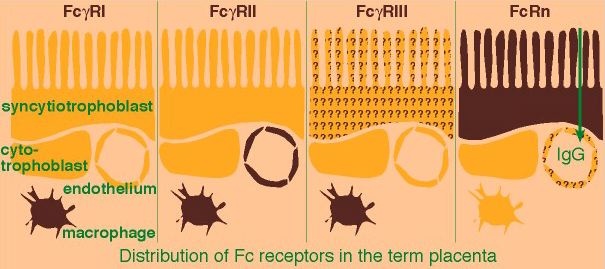Neil Simister
 Associate Professor of Biology
Associate Professor of Biology
Research Description
The goal of our research is to describe in molecular terms how immunoglobulins are transported from a pregnant or nursing mammal to her unborn or newborn offspring. Although the fetus is capable of an immune response, it is normally sheltered from foreign antigens and does not make antibodies against them. The mother is not sheltered. Because the antigenic environment she lives in during pregnancy approximates that awaiting the neonate, a mother makes the antibodies her offspring will need. Maternal IgG antibodies are transmitted to fetal or newborn mammals and provide immunity during the first weeks of independent life. Rats and mice receive most maternal IgG as sucklings, from milk, whereas most evidence suggests that human mothers pass on IgG only before their child's birth.
Receptors for the Fc region of IgG have been detected in the intestines of suckling rodents and in human placentae. In suckling rats, IgG binds an Fc receptor at the surface of intestinal epithelial cells, and is internalized. IgG crosses these cells and is released into the plasma. From here it passes through capillary endothelia into the bloodstream. We purified the Fc receptor, called FcRn, and found it to be a dimmer of ß2-microglobulin and a 51 kDa glycoprotein. We cloned cDNAs encoding the glycoprotein. Its predicted amino acid sequence revealed homology with the class I molecules of the major histocompatibility complex. Our current research uses expression of normal and mutant FcRns in cultured mammalian cells as an approach to identifying the binding site of the receptor for IgG, and to locating sorting signals that direct its transport across the cell.
Most materno-fetal IgG transport occurs after the 22nd week of human pregnancy. During this time there are two cellular barriers in the placenta that IgG must cross: the syncytiotrophoblast and the fetal capillaryendothelium. IgG has been detected by immunoelectron microscopy in vesicles in the syncytiotrophoblast and endothelial cells. These vesicles are presumed to mediate transcytosis of IgG in placenta. We have recently cloned cDNA encoding a human homolog of the rat FcRn from a human placental library. We detect FcRnmRNA and protein in the syncytiotrophoblast of first trimester and termplacenta. This pattern of expression is consistent with a role for hFcRn intransport of maternal IgG to the fetal circulation across the placentalsyncytiotrophoblast, but not the endothelium.

Selected Publications
- Liu X, Ye L, Bai Y, Mojidi H, Simister NE, Zhu X (2008). "Activation of the JAK/STAT-1 signaling pathway by IFN-gamma can down-regulate functional expression of the MHC class I-related neonatal Fc receptor for IgG." J Immunol. 2008 Jul 1;181(1):449-63.
- Ye L, Tuo W, Liu X, Simister NE, Zhu X (2008). "Identification and characterization of an alternatively spliced variant of the MHC class I-related porcine neonatal Fc receptor for IgG." Dev Comp Immunol. 2008;32(8):966-79.
- Newton EE, Wu Z, Simister NE (2005)."Characterization of basolateral-targeting signals in the neonatal Fc receptor." J Cell Sci. 2005 Jun 1;118(Pt 11):2461-9.
- Wernick NL, Haucke V, Simister NE (2005). "Recognition of the tryptophan-based endocytosis signal in the neonatal Fc Receptor by the mu subunit of adaptor protein-2." J Biol Chem. 2005 Feb 25; 280(8):7309-16.
- Bitonti AJ, Dumont JA, Low SC, Peters RT, Kropp KE, Palombella VJ, Stattel JM, Lu Y, Tan CA, Song JJ, Garcia AM, Simister NE, Spiekermann GM, Lencer WI, Blumberg RS (2004). "Pulmonary delivery of an erythropoietin Fc fusion protein in non-human primates through an immunoglobulin transport pathway." Proc Natl Acad Sci U S A. 2004 Jun 29; 101(26):9763-8.
- Simister NE (2003). "Placental transport of immunoglobulin G." Vaccine. 21:3365-9
- McCarthy, K.M., M. Lam, L. Subramanian, R. Shakya, Z. Wu, E.E. Newton and N.E. Simister (2001). "Effects of mutations in potential phosphorylation sites on transcytosis of FcRn." J. Cell Sci. 114:1591-1598.
- Wu, Z. and N.E. Simister (2001). "Tryptophan- and dileucine-based endocytosis signals in the neonatal Fc receptor." J. Biol. Chem., 276: 5240-5247.
- Mikulska, J.E., L. Pablo, J. Canel and N.E. Simister (2000). "Cloning and analysis of the gene encoding the human neonatal Fc receptor." Eur. J. Immunogenetics 27: 231-240.
- Mikulska, J.E. and N.E. Simister (2000). "Analysis of the promoter region of the human FcRn gene." Biochim. Biophys. Acta, 1492:180-184.
- McCarthy, K.M., Y.L. Yoong and N.E. Simister (2000). "Bidirectionaltranscytosis of IgG by the rat neonatal Fc receptor expressed in a rat kidney cell line: a system to study protein transport across epithelia." J.Cell Sci. 113:1277-1285.